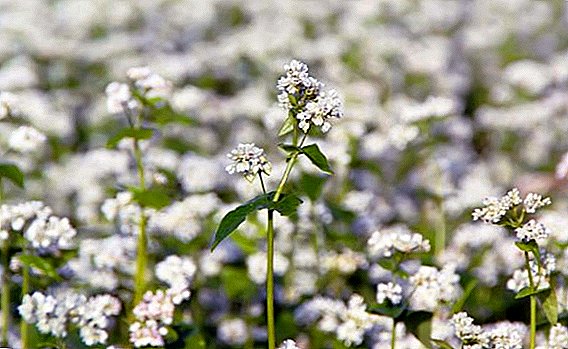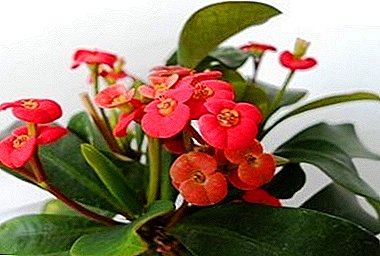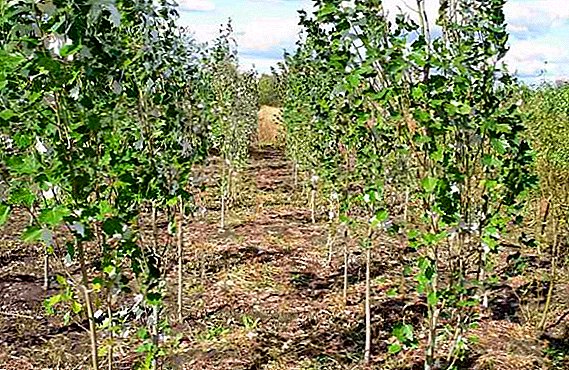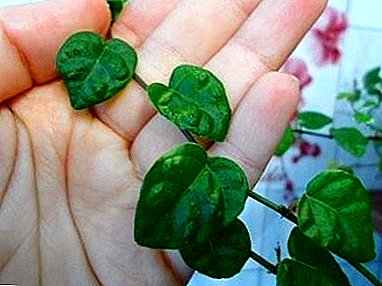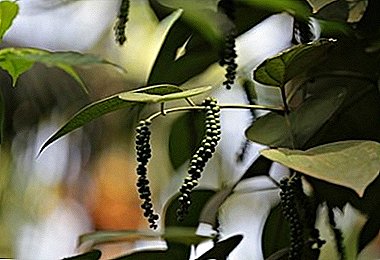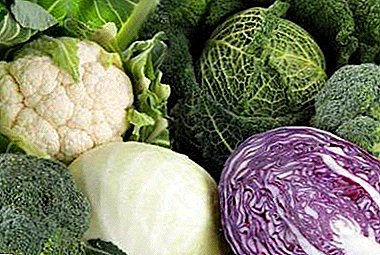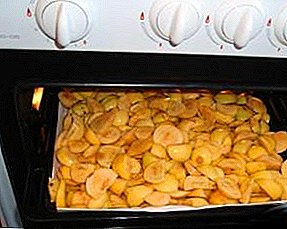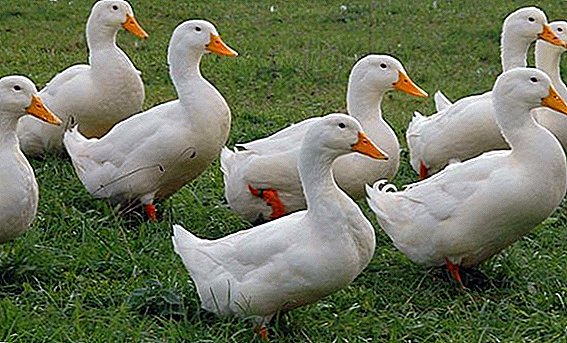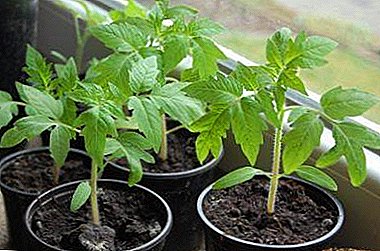
Growing healthy strong tomato seedlings is a laborious process of creating comfortable conditions for it, taking into account the light conditions, air temperature, irrigation time and many other factors.
Sometimes tomato seedlings at home become too long and thin, and if you do not know what to do in such cases, you can ruin all the seedlings.
Simple rules of care allow you to protect seedlings from pulling the stems, so that they grow healthy, fluffy and stable.
What does pulling tomatoes mean and what can it lead to?
Pulling a seedling tomato is the elongation and simultaneous thinning of the stalks of seedlings, what is happening in a short time if non-compliance with the rules of care. In this case, by the time the seedlings are planted, it is not compact, strong seedlings that grows, but fragile, thin and sluggish shoots that have an excessively long stem that loses stability and is not held upright.
Rooting of such seedlings is significantly inhibited, and rooted plants develop slowly, they do not bloom well and bear poor fruit.
The reasons
Tomato seedlings are pulled out as a result of violations of the principles of care. The reasons may be the following:
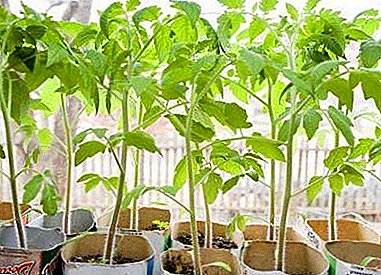 Insufficient lighting. From the time the seeds are sown, the plants need good daylight. For tomatoes, the southern side is preferred. They are not recommended to be placed away from the light source (windows). In the absence of illumination, the seedlings will be sluggish and faded, drawn out quickly enough within one week.
Insufficient lighting. From the time the seeds are sown, the plants need good daylight. For tomatoes, the southern side is preferred. They are not recommended to be placed away from the light source (windows). In the absence of illumination, the seedlings will be sluggish and faded, drawn out quickly enough within one week.- Non-compliance with temperature regime. Seedlings of tomatoes need a temperate warm climate. Daytime temperature should be within 18-25 degrees, night - 14-16 degrees. When the temperature is too high or too low, the seedlings are drawn out and give little foliage.
- Irrigation disorders. Tomato sprouts are pulled out with too frequent watering, thus the seedlings increase the root system and protect themselves from rotting.
- Overly tight fit leading to a shortage of not only space, but also light and nutrients. Seedlings begin to block each other, their foliage crushes. This leads to a gradual elongation of the stems of the seedlings, which become uneven and thin, may fall.
- Excess nutrients in particular, nitrogen and phosphorus. Improper dosage of fertilizers or improperly selected soil, which is inappropriate for tomatoes by the number of trace elements, leads to a rapid stretching of the seedlings and a significant underdevelopment of the root system. When transplanting to a permanent place, such seedlings often cannot root.
- Lack of potassium in the soil. A lack of potassium is observed when preparing the soil independently by gardeners, as well as using old, clay or sandy soil. In this case, the seedlings are stretched very strongly, and the cotyledon leaves are high.
- Violation of the timing of planting seedlings. Occurs when sowing seeds too early or in an unfavorable climate, when the seedlings cannot be planted in open ground at the recommended time. In the future, such seedlings may not bloom and die.
- Too deep planting seeds. It leads to the fact that seedlings too long come to the ground surface and continue to grow elongated in the future.
How to grow seedlings at home so that they do not stretch strongly up?
To seedlings not stretched, it is recommended to adhere to some rules:
- Sowing seeds strictly in the time specified in the instructions on the packaging of seeds (in late February or early March). Under adverse climatic conditions, it is preferable to use early varieties that will have time to go through their growing season.
- Do not be late with transplanting seedlings to a permanent place.
- Use for planting quality seeds with not expired.
- Consider the time of daylight for the location of seedlings.
- Use a suitable substrate for tomatoes, which should be loose, nutritious and well drained.
- Apply mineral fertilizers in proper breeding. If the fertilizer is prepared by hand, then use peat, compost and soil in the ratio of 3: 2: 1.
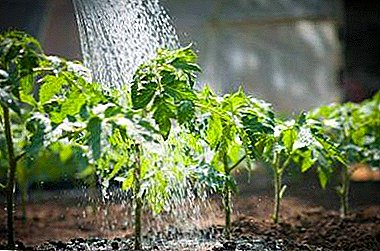 To conduct regular watering, but to avoid the formation of a crust on the soil. Tomatoes prefer abundant, but not frequent watering with full or almost complete drying of the soil instead of daily small watering. Water should be separated and warm, not lower than 30 degrees. Watering of seedlings is carried out 1 time in 3-4 days (when leaves start to fall at the seedlings).
To conduct regular watering, but to avoid the formation of a crust on the soil. Tomatoes prefer abundant, but not frequent watering with full or almost complete drying of the soil instead of daily small watering. Water should be separated and warm, not lower than 30 degrees. Watering of seedlings is carried out 1 time in 3-4 days (when leaves start to fall at the seedlings).- Consider the type of variety (early, mid-season or late).
- They do not use land for planting, in which the nightshade (eggplants, potatoes, tomatoes) have been growing for the past 3 years.
- Before sowing, the seeds are soaked in a day with a weak solution of potassium permanganate (1: 5000). In dilution with water, potassium permanganate gives off potassium, which is necessary for seedlings for moderate growth.
- Seeds are sown to a depth of not more than 1.5 centimeters.
- After sowing, the seeds are covered with foil. Warm environment contributes to the proper growth of seedlings (temperature 22-25 degrees).
- Be sure to remove the film after the emergence of shoots - then their root system will begin to develop. If this is not done, the seedlings will grow elongated, tender and with short thin roots.
- Since the seedlings are drawn out in an extremely warm environment, they should not be constantly kept at the top, where the air temperature is somewhat higher. During the development of the roots, it is better to lower the crates or cups to the floor.
- After the emergence of 2-3 true leaves of a seedling, it dives, the containers are filled with a nutrient substrate, the roots of the plant are slightly shortened and buried by 1.5-2 cm. For the third time, tomatoes dive after 3 weeks, filling them with earth to the first true leaves.
Repeated picking contributes to the development of the root system and prevents stretching.
What if saplings become thin and long?
Additional lighting
With a lack of lighting, seedlings are carried out on the glazed balcony. on the south side (allowed south-east, south-west side) or install lamps. Fluorescent lamps are placed at a distance of 5-6 cm from the top leaflets of seedlings.
Temperature change
Lowering the temperature to 15-16 degrees stops the growth of seedlings and is an effective measure to help the seedlings, as it needs heat only for the first time. During the picking, they keep to warm temperatures, after which they again reduce it to 15 degrees.
Deepening
At the same time, plants are dived into separate containers, submerging the stems into the ground to a depth of 3-4 cm, or by deepening the seedling in a tilted position (its surface part should remain vertical). If the seedlings are stretched out in individual containers, then the ground is filled into it in such a way that the soil layer does not reach the cotyledon leaves 2-3 cm.
Watering mode
Water the seedlings regularly: first once a week, then once every 3 days. Use warm water. Watering with cold water leads to rotting of the roots. If the soil is wet, and the leaves of the seedlings are sluggish and drooping, the seedlings should not be watered - it must be moved to a place protected from direct sunlight until the soil is completely dry. After that, watering is done normally.
Top dressing
 For stretched tomato seedlings do not use nitrogen fertilizers, which contribute to further stretching of the stems. Potassium and phosphate fertilizers, ash (20 grams per 200 ml of water) are preferred. If, together with the stretching, the seedlings become pale, then urea is added to the fertilizer at the rate of 20 grams per 10 liters and the seedlings are removed for a week in a cool place (10 degrees Celsius).
For stretched tomato seedlings do not use nitrogen fertilizers, which contribute to further stretching of the stems. Potassium and phosphate fertilizers, ash (20 grams per 200 ml of water) are preferred. If, together with the stretching, the seedlings become pale, then urea is added to the fertilizer at the rate of 20 grams per 10 liters and the seedlings are removed for a week in a cool place (10 degrees Celsius).
Seedling growth will slow, and the foliage will turn bright green. Before disembarking, seedlings should be sprayed with a solution of serum with iodine. (5 drops of iodine, 200 ml of serum, 1 liter of water).
Growth Regulator Treatment
Plant growth regulators are used twice ("Heteroauxin", "Zircon", "Biosil", "Emistim", "Reggae") at the moment of the appearance of the second pair of true leaves and 2 weeks later, adding fertilizer to the root and not falling on the foliage.
Removal of cotyledon leaves
Cotyledon leaves are the first leaves of seedlings that have an elongated oval shape. Their pinching effectively inhibits plant growth and strengthens the stems. It is better to remove the cotyledon leaves with scissors in order not to damage the delicate stems. You can delete them in turn: the second sheet a week after the first. This method is suitable only for early seedlings.
Topping
Pinching is cutting the tops of the tomato seedlings with 5-6 true leaves remaining on the stem. Cut the tip can be placed in water for 7-10 days for the appearance of roots, and then planted in the ground. Cut seedlings quickly give new shoots at the cut point.
When the size of the shoots exceed 5 cm, 2 upper stepsons are left on the stem, removing all the others. Pruning of stepsons is carried out strictly 3 weeks before planting the seedlings to a permanent place.
Failure to follow the rules of care leads to a rapid thinning and lengthening of tomato seedlings. There are many ways to prevent this process, given the characteristics of the plant itself and the cultivation agrotechnical method. If the pull did occur, gardeners have every chance to save the seedlings using simple and affordable methods.


 Insufficient lighting. From the time the seeds are sown, the plants need good daylight. For tomatoes, the southern side is preferred. They are not recommended to be placed away from the light source (windows). In the absence of illumination, the seedlings will be sluggish and faded, drawn out quickly enough within one week.
Insufficient lighting. From the time the seeds are sown, the plants need good daylight. For tomatoes, the southern side is preferred. They are not recommended to be placed away from the light source (windows). In the absence of illumination, the seedlings will be sluggish and faded, drawn out quickly enough within one week. To conduct regular watering, but to avoid the formation of a crust on the soil. Tomatoes prefer abundant, but not frequent watering with full or almost complete drying of the soil instead of daily small watering. Water should be separated and warm, not lower than 30 degrees. Watering of seedlings is carried out 1 time in 3-4 days (when leaves start to fall at the seedlings).
To conduct regular watering, but to avoid the formation of a crust on the soil. Tomatoes prefer abundant, but not frequent watering with full or almost complete drying of the soil instead of daily small watering. Water should be separated and warm, not lower than 30 degrees. Watering of seedlings is carried out 1 time in 3-4 days (when leaves start to fall at the seedlings).